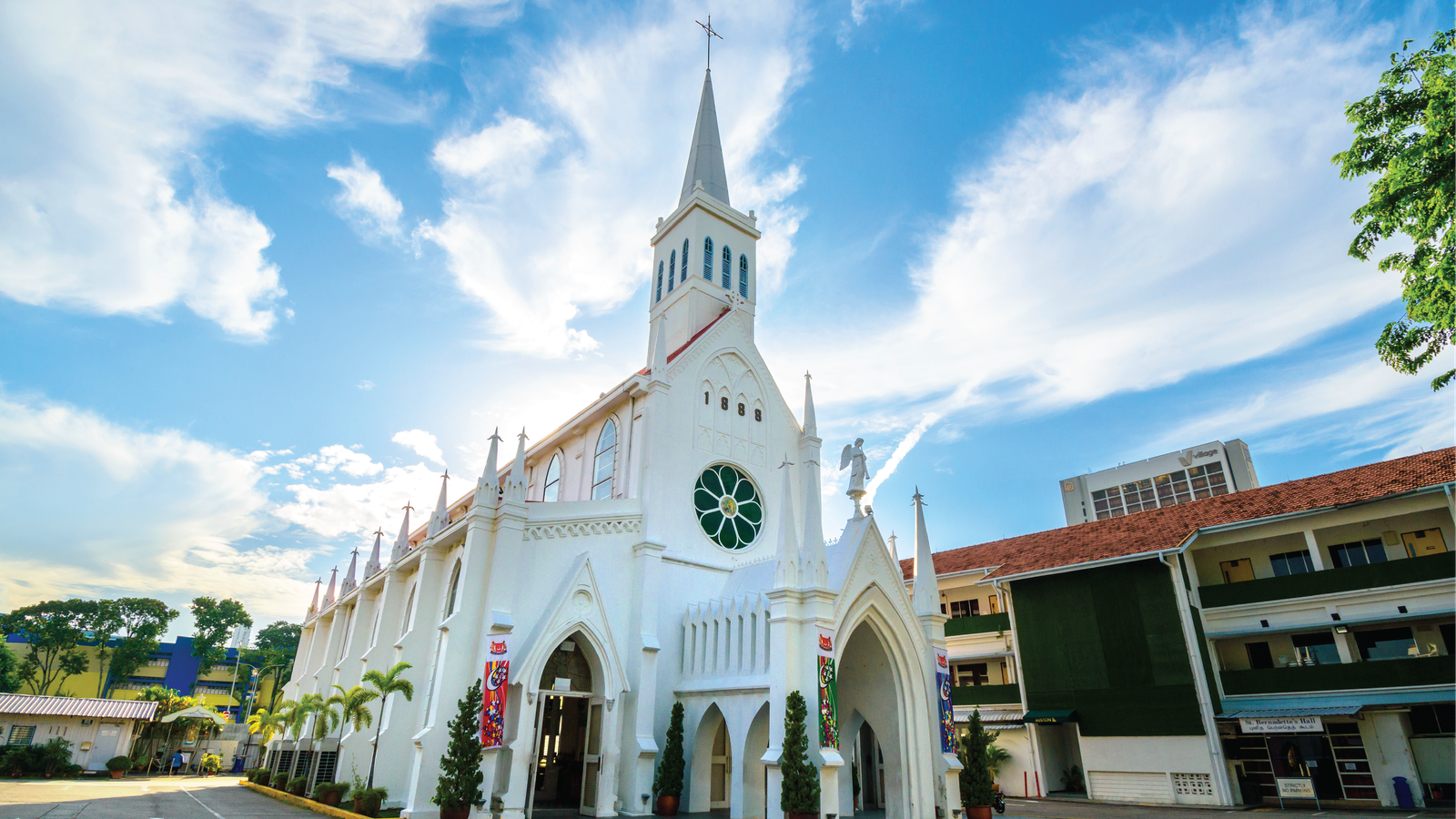
About Our Parish
History of Catholicism in Singapore
The earliest known presence of Catholics in Singapore can be traced to 1821, when a Paris Foreign Missions Society (MEP) priest, Rev Fr Laurent Marie Joseph Imbert, arrived on a visit to our shores and found a dozen abandoned Catholics who asked for a priest to mister to the spiritual needs.
He first came into contact with an Indian family, and later, an individual Indian Catholic, both of whom graciously extended their hospitality to the priest to lodge at their home. His early encounters with these Indian Catholics present in Singapore.
With to arrival of Fr Jean Marie Beurel, funds were raised to build the Church of the Good Shepherd at Queen Street and was completed in 1847. It replaced a small chapel located along Bras Basah Road, which later became the site of St Joseph’s Institution. In 1888 the previously defunct Diocese of Malacca was restored, thus raising the Vicariate of Malacca to a Diocese, and therefore elevating Vicar Apostolic Edouard Gasnier to Titular Roman Catholic Bishop of Malacca, with his official residence in Singapore. As the seat of the Bishop, the Church of the Good Shepherd was thus raised to the status of Cathedral.
The earliest known presence of Catholics in Singapore can be traced to 1821, when a Paris Foreign Missions Society (MEP) priest, Rev Fr Laurent Marie Joseph Imbert, arrived on a visit to our shores and found a dozen abandoned Catholics who asked for a priest to mister to the spiritual needs.
He first came into contact with an Indian family, and later, an individual Indian Catholic, both of whom graciously extended their hospitality to the priest to lodge at their home. His early encounters with these Indian Catholics present in Singapore.
With to arrival of Fr Jean Marie Beurel, funds were raised to build the Church of the Good Shepherd at Queen Street and was completed in 1847. It replaced a small chapel located along Bras Basah Road, which later became the site of St Joseph’s Institution. In 1888 the previously defunct Diocese of Malacca was restored, thus raising the Vicariate of Malacca to a Diocese, and therefore elevating Vicar Apostolic Edouard Gasnier to Titular Roman Catholic Bishop of Malacca, with his official residence in Singapore. As the seat of the Bishop, the Church of the Good Shepherd was thus raised to the status of Cathedral.
The Founding of an Indian Church
The church was built in the mould of the Basilica at Lourdes, France. Its architecture, complete with fine trimmings and grand arches, was gothic with cornices and pilasters, tracery parapets, louvered wooden French windows and unglazed natural coloured tile roof.
The building underwent several renovation works. Between 1958 and 1959, for instance, the original 15 stained glass windows at the clerestory, broken during World War II, were restored in major renovations undertaken by Father Fortier. These windows depicted the 15 mysteries of the Holy Rosary. Fortier also undertook the installation of a set of electronic bells, and the construction of a second loft to accommodate a growing congregation.
Gothic in character, there are curious anomalies in the church design. The main doors to the west end are similar to those found in a godown. The exterior walls are supported by buttresses. In the interior, instead of a chancel, the nave is rounded at the altar end, and aisles extend in an arc round the church. The interior feels light and open because the columns in the colonnade are made of cast iron, and therefore much slimmer than masonry. The nave rises to a clerestory above, flooding the church with natural light. In place of a conventional altar, Our Lady of Lourdes has a small replica of the grotto of Lourdes with the Virgin Mary standing in it. A remarkable crucifix with outstretched arms hangs on the wall near the altar, and legend relates that when thieves once tried to wrest it from its place, it refused to move. At the back of the church in one corner, a splendid wrought-iron spiral staircase gives access to the choir stalls and the organ.
The windows of the church have a modernistic approach and are one of the best specimens with good craftsmanship. In line with the preservation of Our Lady of Lourdes as a monument, restoration works amounting to S$1.75 million were undertaken in 2009 to restore it to resemble the original church. And being an old church built in 1888, it will undergo another renovation and restoration at a cost of about S$6.5 million. And again, we expect your loving generosity. Thank you.
Two brass tablets have been set up at the church in remembrance of the services of two priests, Father Meneuvrier and Father Burghoffer. Meneuvrier was the first missionary to Singapore who was put in charge of the Indian Catholics here, while his successor, Burghoffer, had put in 34 years of valuable service towards the growth of the church.
The Catholic Ministry for Indians of the Church of Our Lady of Lourdes or the Indian Church, as it was then referred to, was officially established in 1884. Unofficially, the Indian Mission started taking root as early as 1858.
The first sheperd for the first group of pioneering India Catholics, Fr Pierre Paris, took upon himself to care for them; he taught catechism, baptized, preached, counselled and celebrated the Eucharist for them, in Tamil, each Sunday from 1856 until he passed away from 1883. He also provided education for them. He ministered the early Indian Catholics from the Church of Sts Peter and Paul along Queen Street.
Upon the passing of Fr Paris, there was no dedicated pastor for the Indian Catholics until Fr Joachim Alexandre Marie Meneuvier was entrusted with the ministering of the community starting in 1884. He was tasked to undertake the learning of the Tamil language and the building of a separate church for the Indian Catholics by Bishop Edouard Gasnier.

